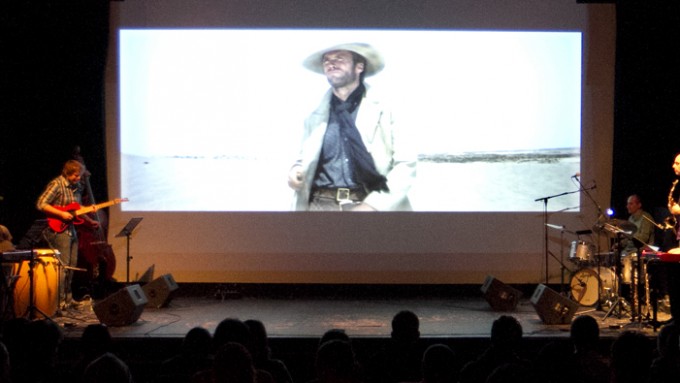Keith Price composed a new improvised soundtrack for parts of the film,’ The Good, The Bad, And The Ugly’. The film was treated as silent and the material was inspired by the jazz fusion period of the 1970’s.
Shaking up a spaghetti western
Guitarist goes the extra Miles to give film a new score
By: Chris Smith
The Good, the Bad & the Ugly
Guitarist Keith Price is re-scoring the classic 1966 spaghetti western The Good, the Bad and the Ugly without having heard the distinctive original by celebrated film composer Ennio Morricone.
And if that seems a bit reckless, it actually makes sense.
Price rightly believes that his writing would be influenced if he was familiar with the original soundtrack, which stayed on the charts for more than a year and whose title composition became a hit for Hugo Montenegro in 1968.
The Winnipeg guitarist is also right when he says he probably wouldn’t even have attempted the project for Jazz Winnipeg’s Nu Sounds series if he was competing with the celebrated Morricone.
In fact, Price’s first encounter with the movie was visual only — in a bar in Toronto with the film on the TV and the sound turned off.
Morricone’s compositions for the film included gunfire, whistling and yodelling. The main theme resembles the howling of a coyote and is a two-note melody used throughout the film.
“While working on it, I didn’t have the sound or subtitles on so I’d be free,” to compose without preconceived notions, he says in an interview. “I didn’t listen to the score so I wouldn’t be influenced. I couldn’t be creative with (Morricone’s) world-famous melodies in my mind.
“I have the gist of the story now,” he adds with a laugh.
“I felt ’70s Miles Davis music would work with this,” Price says, citing the rebel images of the cowboy characters in the film, played by Clint Eastwood, Eli Wallach and Lee Van Cleef, and of the famed trumpeter who opened a rift in the jazz world when he embraced electric instruments and shook things up with his Bitches Brew album.
“It really does fit,” Price says. “It’s fun, it works.”
Price’s show will consist of two 45- to 50-minute sets, not long enough to screen the two-hour, 41-minute film. “The first 50 minutes will be uncut,” Price says, “then a desert scene I like from later on, then the end of the film.
“I know the original score is quite famous. (Director Sergio) Leone even extended scenes because he liked the music.”
Guitarist Price will lead an eight-piece band: Jeff Presslaff and Will Bonness on keyboards; Neil Watson on saxophone; Marty Thiessen on electric bass; Julian Bradford on acoustic bass; Scott Senior on percussion; and Jaime Carrasco on drums.
Leading is a relative term, of course, as Price says. “I’m not scoring it all. I have written sketches for scenes, leaving lots of space to be improvising in. I really don’t know what it will sound like; things will happen on the fly — kind of raw.
“We’ll have two long rehearsals, but a lot of it will be improvised,” he adds.
Price says Davis’s fusion style, from the 1969 In a Silent Way album to the trumpeter’s retirement from playing in 1976, influenced what writing he is doing. “It will definitely sound a lot like that period,” he says.
As for the movie, with its original sound: “I’m looking forward to watching it when I’m done,” Price says.
